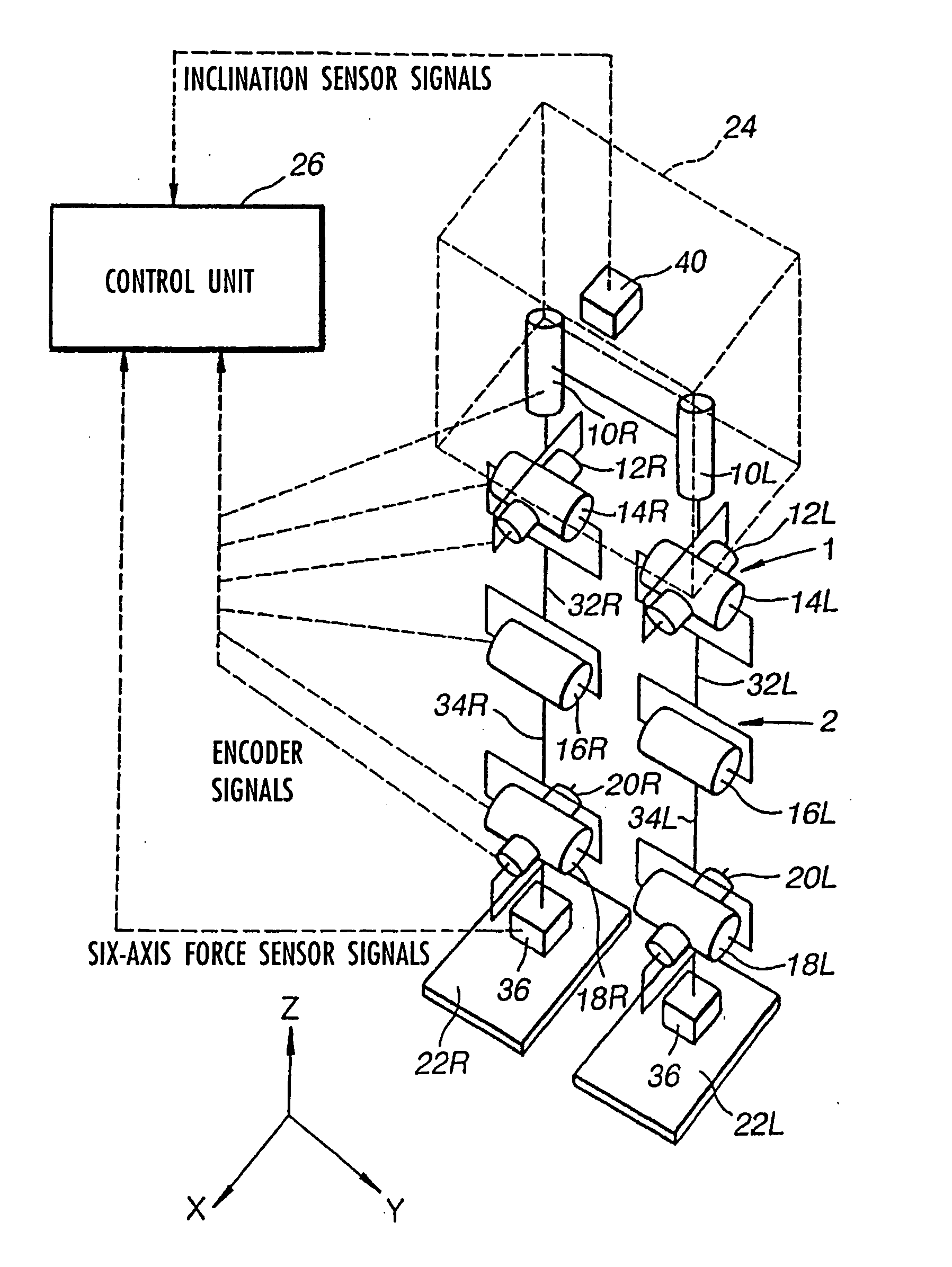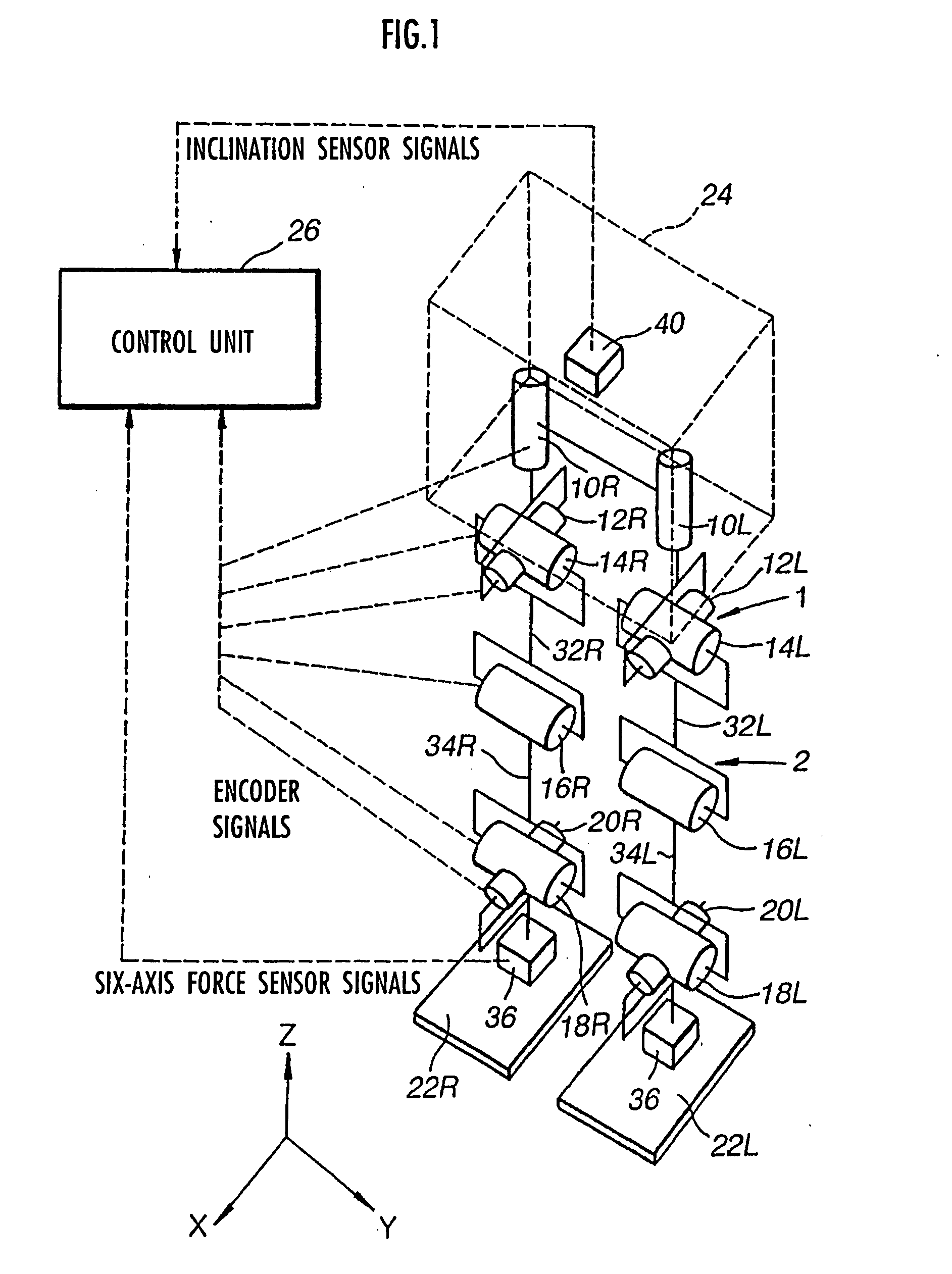Controller of legged mobile robot
a mobile robot and control device technology, applied in the direction of electric programme control, program control, instruments, etc., can solve the problems of no effect of recovering posture, low stability and unstable posture of legged mobile robots with two legs, so as to ensure the stability of the posture of the robot.
- Summary
- Abstract
- Description
- Claims
- Application Information
AI Technical Summary
Benefits of technology
Problems solved by technology
Method used
Image
Examples
first embodiment
[0114]FIG. 3 is a block diagram showing the entire functional configuration of the control device of the robot 1 in this invention. Portions other than the “actual robot” in FIG. 3 are configured by processing functions (mainly functions of the first calculator 60 and the second calculator 62) executed by the control unit 26. In the description below, Reference Symbols R and L are omitted when it is not necessary to identify the right and left legs 2.
[0115] The actuation of the control device of this embodiment is outlined with reference to FIG. 3. The control unit 26 generates a desired gait by the use of a gait generating device 100 as described later. The desired gait generated and outputted by the gait generating device 100 includes desired body position / posture trajectories (trajectories of desired position and posture of the body 24), desired foot position / posture trajectories (trajectories of desired position and posture of each foot 22), desired arm posture trajectories (tra...
second embodiment
[0429] The floor reaction force's moment allowable range is for limiting the desired floor reaction force's moment of the compliance control, in order to prevent such problems. To be precise, the floor reaction force's moment allowable range is set for a recovery condition 1 described in the second embodiment described later. However, in the case of satisfying forgoing Equation d27 like this embodiment, setting the floor reaction force's moment allowable range for the recovery condition 1 is equivalent to limiting the desired floor reaction force's moment for compliance control not to exceed the floor reaction force's moment allowable range.
[0430] Therefore, it is preferred that the floor reaction force's moment allowable range be set so that the floor reaction force central point allowable range obtained by dividing the floor reaction force's moment allowable range by the floor reaction force's vertical component, is included in the range where the ZMP can exist.
[0431] To be more ...
third embodiment
[0500] As shown in each of FIGS. 53 and 54, where are intersection points between the line having the aforementioned inclination h and the aforementioned allowable range region (rectangular regions in each drawing), (Fltd, Mltd) are determined as values of the floor reaction force's horizontal component and floor reaction force's moment which correspond to an intersection point (black circle in the drawings) closest to the point of (Fin, Min) among the above-mentioned intersection points. When the group of (Fltd, Mltd) is determined in this manner, it is prioritized that the model's body posture angle stabilization floor reaction force's moment obtained by the use of later-described Equations e01 and e02 coincides with the required value of model's body posture angle stabilization floor reaction force's moment Mrfdmd. Based on this, the model's body horizontal position stabilization floor reaction force's moment becomes closest to the required value of model's body horizontal positi...
PUM
 Login to View More
Login to View More Abstract
Description
Claims
Application Information
 Login to View More
Login to View More - R&D
- Intellectual Property
- Life Sciences
- Materials
- Tech Scout
- Unparalleled Data Quality
- Higher Quality Content
- 60% Fewer Hallucinations
Browse by: Latest US Patents, China's latest patents, Technical Efficacy Thesaurus, Application Domain, Technology Topic, Popular Technical Reports.
© 2025 PatSnap. All rights reserved.Legal|Privacy policy|Modern Slavery Act Transparency Statement|Sitemap|About US| Contact US: help@patsnap.com



